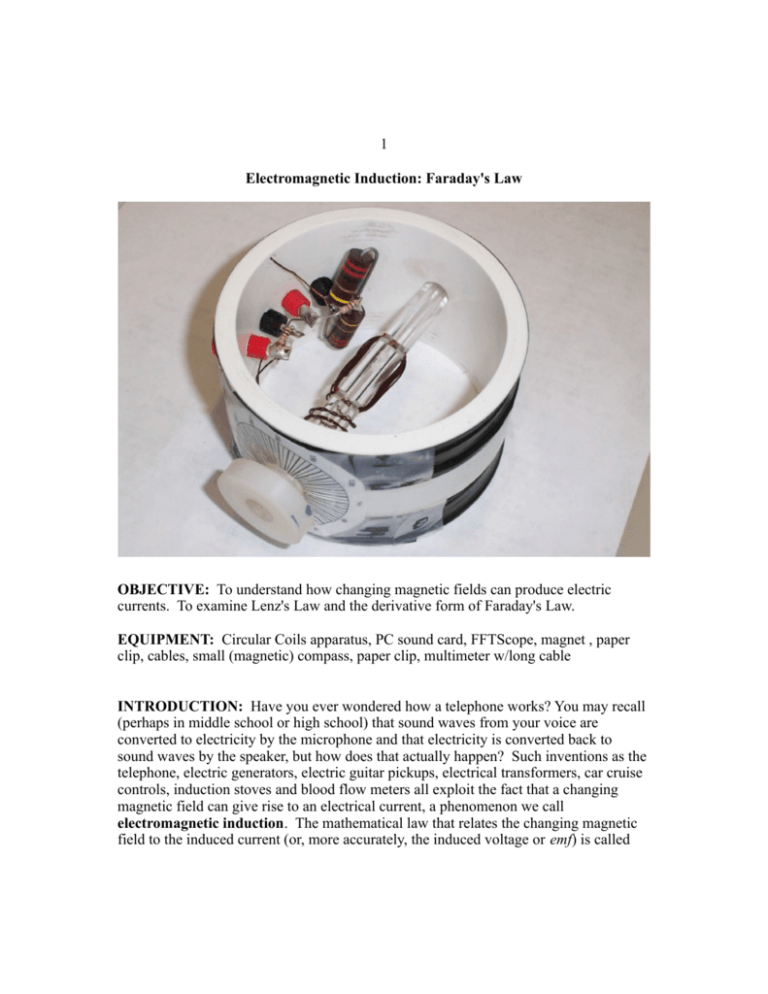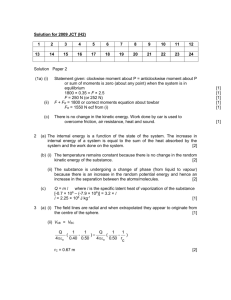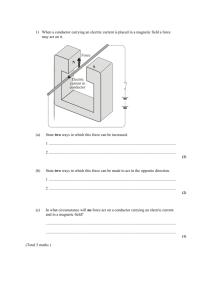Electromagnetic Induction: Faraday's Law
advertisement

1 Electromagnetic Induction: Faraday's Law OBJECTIVE: To understand how changing magnetic fields can produce electric currents. To examine Lenz's Law and the derivative form of Faraday's Law. EQUIPMENT: Circular Coils apparatus, PC sound card, FFTScope, magnet , paper clip, cables, small (magnetic) compass, paper clip, multimeter w/long cable INTRODUCTION: Have you ever wondered how a telephone works? You may recall (perhaps in middle school or high school) that sound waves from your voice are converted to electricity by the microphone and that electricity is converted back to sound waves by the speaker, but how does that actually happen? Such inventions as the telephone, electric generators, electric guitar pickups, electrical transformers, car cruise controls, induction stoves and blood flow meters all exploit the fact that a changing magnetic field can give rise to an electrical current, a phenomenon we call electromagnetic induction. The mathematical law that relates the changing magnetic field to the induced current (or, more accurately, the induced voltage or emf) is called 2 Faraday's Law, named after the man (among others) who first observed it in the laboratory around 1830. You may recall from lecture that magnetic flux through a surface in a magnetic field B is = ∫ B. n dA where n is a unit vector perpendicular to area element dA note that if B is constant and the surface is a plane with area A, this reduces to =B Acos A conducting loop which has an ammeter attached to it will register a current if the magnetic flux through the loop changes in time. The change may arise from motion: Or the change in flux may be due to the changing current in a circuit. In (a) below there is no induced emf in loop 2 but when the battery is connected, the increasing current in loop 1 produces a changing magnetic field and hence induces an emf in loop 2. 3 Faraday noted that the emf induced in a loop is proportional to the rate of change of magnetic flux though it: =−N d dt where is the electromotive force induced (measured in volts) and N is the number of turns of the coil. Provided each turn of the coil is sized and oriented like the others, its contribution is simply additive; hence the coefficient N in front of the flux derivative. Notice the negative sign. Lenz's Law states that the induced emf (and current) will be in a direction such that the induced magnetic field opposes the original magnetic flux change. Keep in mind that the induced current will now produce an induced magnetic field. The direction of that magnetic field will be opposite to the direction the flux is changing: APPARATUS: Examine the apparatus. There are three sets of coils, two of which are fixed with respect to each other (wrapped in black tape) and which share the same number of turns and diameter. These two coils (total number of turns N=20) act in concert with each other, each producing a magnetic field in the same direction. These outer coils produce a fairly uniform magnetic field inside the apparatus – recall the Helmholtz Coils setup from the E&M Forces lab that generated a field that remained constant throughout the path of the electron beam. 4 The third inner coil (total number of turns N=11) is more rectangular than circular, smaller than the other two, and can be rotated with respect to them using the knob on the side of the apparatus. There are protractor markings around the knob to measure the angle between inner and outer coils. FFTScope software, which controls the PC's sound card, will act as a singal generator. It will be used to drive the outer coils with a periodic waveform that will produce a changing magnetic flux, inducing a current in the inner coil. You can also induce a current manually (signal generator off) by moving a small magnet close to the inner coil. In both cases, you will use FFTScope to examine the induded current in the inner coils. PROCEDURE: NOTE: DO NOT DISCONNECT OR CHANGE THE APPARATUS WIRING. PLEASE EXERCISE CARE WITH THE COIL APPARATUS-TURNING THE ANGLE KNOB TOO MUCH IN ONE DIRECTION MAY DAMAGE THE WIRES! A. Induction by moving a constant magnetic field You will induce an emf in the small coil manually, creating a changing flux through the small coil by moving the magnet's magnetic field through it. 1. Examine the magnet on your table. One side of the disk corresponds to magnetic North, the other to South. Draw a diagram of the magnet, sketching magnetic field lines. Determine North and South using the small compass provided, recalling that the compass needle is itself a magnet and that like poles repel (unlike poles attract). Remember that field lines represent lines of force; the more closely together the lines are drawn, the stronger the magnetic force is at that point. If you do not have a clue, pick up the paper clip with one hand, hold the magnet with the other hand, and try to get a rough idea of where around the magnet the clip feels the most force. Draw your diagram on the hand-in sheet. 2. Rotate the knob on the side of the apparatus so that the angle marker is set to 0 or 180 degrees. This should orient the plane of the inner coil parallel to the table. 3. First make sure the volume level on your computer (see right side of menu bar) is somewhere between ½ and ¾ of maximum) and that your external PC speakers are on (knob turned clocksise, green light on). Open FFTScope, which is in the Lab Apps folder on the Desktop. Near the bottom of the app window, select the “Oscilloscope left channel” option – this turns on data acquisition. You should now 5 see the horizontal graph axis, as well as upper and lower numerical limits for the vertical axis. There will also be a red line almost superimposed over the horizontal axis – this is the response trace (curve) of the inner coils, which is the induced signal. 4. Press the Y-Autoscale button near the top. You have shrunk the vertical scale, magnifying the signal. The trace now comes to life; what you are seeing is noise. Press the “3X Zoom out” button to expand the vertical scale, which gives your graph room to display a real signal that you are about to induce using the small magnet. Note the time Sampling Window on the lower right is set to 10ms – a very small time interval; increase this value to 100ms, so that you can have enough room to see the width of the signal you are about to induce. 5. Pick up the small magnet by the sides and hold it such that the plane of the disk is horizontal; if you aren't using the disk magnet, but the long, thin magnet, hold it such that it's oriented vertically (standing up). Now position it right above the inner coil of the apparatus, without touching. Pull the magnet quickly upwards, while watching the 6 trace on the FFTScope screen. If the pulse appears to be too large for the graph window, try Autoscaling while moving the magnet to incude the pulse. You can also freeze the trace of the pulse by pressing the Spacebar on the keyboard – this will enable you to examine it in detail. Does the emf pulse trace go up or down? ______________ Record in hand-in sheet. 6. Flip the magnet over such that the side you previously had up is now down. If you repeated Step 5, which way would expect the pulse to move? Discuss this with your lab partner before proceeding. Record in hand-in sheet. Repeat Step 5. Which way did the pulse actually move? Again, record in hand-in sheet. 7. Keeping the same magnet orientation in the previous step, try rotating the inner coil 180 degrees and again pulling the magnet upwards from it. Which way does the pulse move now? Record in hand-in sheet. 8. Try to get a rough estimate of emf pulse height by freezing the trace (with the Spacebar), clicking on the plot and moving your cursor over the peak of the pulse and reading Left Input value near the bottom of the window. What was the maximum pulse height that you could momentarily generate on the inner coil? (Record) 9. Now orient the inner coil such that its plane is vertical, i.e. 90 degrees with respect to the table, and plane of inner coils. Pull the magnet away from the coil again. What was the maximum pulse height that you could momentarily generate on the inner coil? Record. 7 If you moved the magnet the same way you did before, why is this pulse height different? ______________________________________________________________ In this section we have physically moved a magnet around a coil, inducing a current in it. In order to do this we have performed work on the magnet because we had to oppose a force to keep the magnet moving, even at constant velocity. What is the source of this force? According to Lenz's Law, the induced current produces an induced magnetic field, which is represented by a magnetic moment (denoted by m on the diagram below, which opposes the motion of the magnet. This magnetic moment can be thought of as "virtual magnet" whose poles either oppose or attract the real magnet, depending on the direction of motion. In either case, the direction of induced current can be identified using your right hand: point your extended thumb in the North direction of the magnetic moment; your fingers will curl in the direction the current is going through the loop. Doing work on a magnet to create a current is the basis behind an electrical generator. In hydroelectric dams, falling water turns large paddles connected to electrical generators that convert mechanical energy to electrical energy. Conversely, we can use changing flux to do work. This is the principle behind an electric motor. B. Induction by varying a stationary magnetic field You will now induce an emf in the smaller coil using a changing magnetic field supplied by the outer coils. There will be no motion of the coils involved. The signal generator will provide the outer coils with a fluctuating current to vary the magnetic field, and hence the magnetic flux, through the inner coils. The fluctuating current will be sinusoidal, triangular or square in waveform shape. 8 1. Predict what the response waveforms will look like for sine, triangle and square driving waves. Think of the mathematical relationship between magnetic flux (driving signal) and induced emf (response signal). Draw predicted waveforms in your hand-in sheet. 2. Look at the left side (Signal Generator) of the FFTScope window; it should be set to Off. Change it to Sine. Select the Automatic Trigger On option at the bottom; this will track the waveform and keep it from “travelling”. Click on Oscilloscope Dual Channels at the bottom of the window to simultaneously view both driving waveform (blue) and induced waveform (red). Autoscale to see the entire wave height. Click and drag a rectangle across a portion of the graph – this will “zoom in” on the waveforms, making them appear less compressed in the horizontal direction. You may have to Autoscale again after this. If you zoomed in too much, you can press the Reset X Scale button in the toolbar. Remember that you can always “freeze” the scope waveforms for closer inspection by pressing the Spacebar. Why doesn't the response waveform look “perfect”? There may be a significant distortion of the waveform due to the capacitance of the sound card in the Mac you are using; you may have learned from lecture that capcitance is a restorative force analogous to a spring in Mechanics. This accounts for the “reflection” pulse (opposite in sign to the true, initial pulse – the left side of the waveform) that you will see. Always note the orientation of the true pulse. 3. Switch to the other waveforms – triangle, square. Quickly check that the frequency and amplitude (driving signal only) remain the same as you toggle between them; only the shape changes. If you are seeing a noisy signal when you Autoscale, turn up the volume knob on the PC speakers; however, if you are getting flat-topped driving waveforms, you are overloading the sound card input - turn down the volume knob. 4. Sketch the induced response for the sine, square and triangular waveforms on the hand-in sheet. 5. Examine the graphs you just drew. What is the general relationship between the driving and induced waveforms? Write your answer on the hand-in sheet. Think of the mathematical relationship between magnetic flux and the emf and note that spikes in the graph represent a very rapid rate of change. Remember that the derivative of a function is very similar to the slope. 9 6. Let us now check how magnetic flux through the smaller coil changes as we rotate it within the fairly uniform field of the outer coils. Make sure Sine is selected in the Signal Generator on the left. Increase the frequency to 5000 Hz by entering this value in the lower-left corner of the FFTScope window; this will provide more sensitivity in the measurement of the response amplitude. Don't worry about the stability of the scope trace; we are only interested in examining the amplitude as a function of angle. Start off with an inner coil angle of 0 degrees (coil plane parallel to table). Select Oscilloscope Left Channel, since we are only examining the response trace. Vary the relative angle between inner and outer coils from 0 0 to 3600 in 150 steps, each time recording the peak-to-peak amplitude (the Peak-to-Peak (mv) Left value) a few seconds after changing the angle to give it time to settle down. Record in hand-in sheet. You can then enter the data, plot in Logger Pro, and print. C. Check of Lenz's Law In part A it was not possible to predict the direction of the induced voltage (induced pulse on FFTScope) even if the direction and motion of the magnet's field was known, simply because they way the coil was wound and how it connected to the positive and negative voltmeter (the sound card in the computer) was not visible. You will now wind a cable, connect it to a ammeter (multimeter), and predict the direction of the induced current in your homemade coil when a bar magnet is pulled. You should then perform the experiment and check the result against your prediction. 1. If it's not already connected, connect the long banana-to-banana cable to the multimeter; one end plugged into the COM (ground) terminal, the other into the mA terminal. Set the selector dial to μA (micro amps). 2. Practic winding the cable around two or three of your fingers (as shown below); you should be able to get several turns (N in the Faraday's Law equation.) out of its length. 10 3. Make the prediction: if you partially inserted the bar magnet into the coil (knowing which end was N and which was S), and pulled it out quickly, what would be the direction of the induced current in the coil? Note this convention – if the current enters the ammeter through the left (μA) terminal, the display reads positive (no negative symbol); if the current enters the current through the right (COM) terminal, the display reads negative. If you need help in getting started, refer to the diagram and explanation at the top of Page 6 of this write-up, but remember that what is taking place in the diagram may not the exact same situation as what you are about to do (check to see if your movement is increasing or decreasing your magnetic flux through the coil). 4. Do the experiment: holding your coil steady, take the bar magnet and partially insert it into the coil. Pull it out of the coil, as you did in Part A, and note the reading – particularly the sign on the left side of the multimeter display. This will tell you the direction of the current in the coil. It will be tricky inducing a non-zero reading on the multimeter – too slow of a pull yields zero current; too fast also yields zero current (because it is not sampled continuously). 11 5. Compare your prediction to your result, explaining everything in detail in the handin sheet. Real-life Applications Faraday's Law is the basic principle behind the simple telephone. In a microphone there is a diaphragm, around which a coil is wrapped, which can move back and forth in response to sound waves. A stationary bar magnet, placed near the coil, induces current in the coil which can then be transmitted (with amplification) to the speaker of another telephone. Conversely, when the current reaches the speaker, which consists of another coil/diaphragm/magnet combination, the varying coil current causes the diaphragm to move and displace sound waves: Another direct application of Faraday's Law is a transformer. If the two sets of coils 1 and 2 similar to what you just used were of the same size, we can either increase or decrease voltage by varying the number of turns according to this equation: V 2 =− N2 N1 V1 12 High-voltage transformers are used in conveying electricity from your electrical company to your home. Since power loss on the lines is equal to I 2R, it makes sense to use a high voltage and low current when transporting power over great distances.. Conversely, for safety reasons, low voltage and higher current is used in the home.







